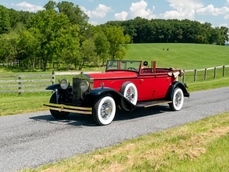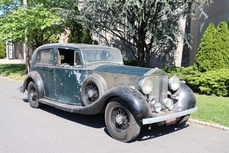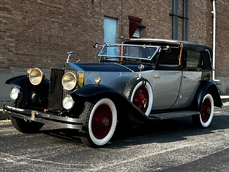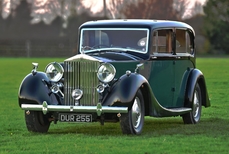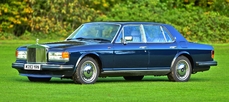Rolls-Royce Phantom II I Four Light Cabriolet Coachwork by Freestone & Webb 1938
Allmän beskrivning :
Vintage and Prestige are proud to offer this 1938 Rolls-Royce Phantom III Four Light Cabriolet Coachwork by Freestone & Webb For Sale.
Chassis no: 3 DL 94
Engine no: Q88N
Design no: 1971
Body no: 1317
Registration: FKN 1
Mileage shown: 35,0147,338cc OHV aluminium V12 engine165bhp at 3,000rpm4-speed manual gearboxIndependent front suspension with coil springs, semi-elliptic springs rear 4-wheel-brakes servo assistedUnique coachworkOnly centre gearshift Phantom III built Perhaps the most outstanding luxury car of the 1930s - certainly to have been built in the United Kingdom - was the Rolls-Royce Phantom III. Introduced in 1936, the 7,340cc V12-engined Phantom III succeeded the Phantom II, the six-cylinder engine of which was considered to be at the end of its development life. The choice of a V12 configuration was a logical one for Rolls-Royce, the company already having had considerable experience of manufacturing V12 aero engines such as that used in the record-breaking Supermarine S6B seaplane. No doubt another consideration was the need to match the multi-cylinder opposition, notably the V16 Cadillac and V12 Hispano-Suiza. A state-of-the-art design employing advanced materials and techniques such as 'skeleton' cylinder blocks with wet liners and aluminum alloy cylinder heads, the PIII V12 produced 165bhp in its debut form. The maximum output was subsequently raised to 180 brake horsepower, which was sufficient to propel later examples to 100mph, earlier models being capable of around 90. Its engine configuration aside, the Phantom III represents an important milestone in the history of Rolls-Royce cars, being the first with independent front suspension. A total of 727 had been manufactured when WW2 halted production, of which around 300 exist worldwide today. By the late 1930s, coachbuilding design had evolved considerably from the 'Roaring Twenties' days, and there were far fewer open sporting bodies built at all on Rolls-Royce automobiles. Gone were the days of lavish spartan 'Torpedos' that were built on the first two series of Phantom chassis. The fashion was slightly more austere and inclined toward two door 'Drophead Coupes' which offered fully open or fully enclosed road conditions, and were more orientated to the owner-driver market. At the top end, luxury cars were still fully coachbuilt operations though, and the buyer of a Rolls-Royce was certainly in a position to decide precisely how their car would look and for what purpose it would be built, and a few of those clientele commissioned full 'all weather' bodies on the V12 Phantom III chassis. The numbers built were certainly modest at the time, and survivors such as this are even fewer. Among its higher brow and rare brethren, this is by any standards a rare automobile. It was ordered new by K.L. Bilbrough of Chislehurst in Kent, in the U.K., a wealthy gentleman who was by then the Chairman of the shipping and marine insurance business his father had founded in 1862. The story goes that its unique creation reflected Mr. Bilbrough's previous penchant for driving Packard motorcars, but when he elected to change for the latest model, he discovered to his dismay that the new car would not fit in his garage!
At this point, two domestic companies took over the mantel, Rolls-Royce and Freestone and Webb. Stipulating that the car must not exceed 17 feet, 7 inches, even with its bumpers fitted, the coachwork was designed. Other intriguing specifics were required, in order to match the central gear-change lever that he was used to in his Packard, the Rolls-Royce was built in this way also, it being the sole example of this model so equipped. White faced instruments were required with black numerals and bezels, and they were to be on a dash panel rather than in the standard cluster. No clock was fitted, nor a Spirit of Ecstasy hood ornament either. Further, he required that it be registered for the road with a license plate that he wouldn't forget, that number was 'FKN1', and when it was delivered to him it must have its odometer zeroed.
There were a number of slightly dated aspects to the order, such as the fitment of a bulb horn when electric horns were of course then the norm, and a four piece windshield which harked back to 1920s coachwork styles more than current traits. Freestone and Webb's design drawings and photos taken in period by Chas. Bowers confirm that the car was very much completed as specified. In fact it must have made quite an impression as Autocar featured the finished Phantom in their magazine in July 1939. It can also be safely assumed that Mr. Bilbrough was happy with his purchase as he would retain it for more than 23 years, in fact until his death in 1962, at the considerable age of 90. At this point the Rolls was sold by his estate, having covered a little under 34,000 miles in its lifetime. The next owner again kept the car until his passing in 2007, a lengthy 45 years of custodianship, at this point the ownership passed to his son. The son retained ownership for another 7 years, a cumulative ownership of 52 years within the same family.
This unique Phantom III must have had one of the simplest lives of any of these cars and for the most part remains highly original in detail and true to the form in which it was delivered new, save for a repaint to its fenders and re-upholstery of its seating areas, but never receiving a full restoration. Its mileage remains extremely low, particularly for these motors, at only 35,014 miles. In more recent times it has been sympathetically maintained by marque experts. She is running smoothly and driving beautifully.
In our showroom ready for viewing.
1938 Rolls-Royce Phantom II I Four Light Cabriolet Coachwork by Freestone & Webb is listed till salu on ClassicDigest in Essex by Prestige House for Ej prissatt.
Fakta i bilen
Karosstyp : Personbil Märke : Rolls-Royce Modell : Phantom II Modellversion : I Four Light Cabriolet Coachwork by Freestone & Webb Motorvolym : 0.0 Årsmodell : 1938 Karosstyp : Convertible Läge : Essex Fordon Registrering : Odefinierad
Ej prissatt
Information om säljaren
Vintage & Prestige
Prestige House
+44(0)1375 379719, +44(0)7967 260673
Prestige House
+44(0)1375 379719, +44(0)7967 260673
People who viewed this Rolls-Royce Phantom II also viewed similar Rolls-Royce listed at ClassicDigest
Other cars listed for sale by this dealer
om Rolls-Royce
Nåväl, damer och herrar, idag dyker vi in i den lysande historien om ett varumärke som alltid har inneburit själva essensen av brittisk lyx och hantverk - Rolls-Royce.Vår historia börjar vid förra sekelskiftet när två visionärer, Charles Rolls och Henry Royce, beslutade att gå samman. År 1904 föddes den allra första Rolls-Royce, Rolls-Royce 10 hp. Det var en blygsam början för ett företag som skulle omdefiniera bilens överlägsenhet.
Men det var inte förrän 1907 som Rolls-Royce verkligen gjorde sin stämpel med introduktionen av Silver Ghost. Den hyllades som "Världens bästa bil" och satte gulstandard för lyxkörning. Med sin tystlåtna motor och utsökta hantverk var det en symbol för överflöd och förfining.
1920-talet förde oss Rolls-Royce Phantom I, en ikon för sin tid. Det var den första Rolls-Royce med en 6-cylindrig motor och lade grunden för den legendariska Phantom-serien. Detta var eran när Maharadjor i Indien beställde specialbyggda Rolls-Royces som var inget mindre än bilpalats.
Snabbspola till efterkrigsåren, och vi har Silver Cloud, en symbol för det brittiska efterkrigsoptimismen. Silver Cloud var elegans personifierad, med sina flytande linjer och handgjorda interiörer. Det var valet för kungligheter, kändisar och kaptenar inom industrin.
Men om vi pratar om Rolls-Royces lyx i sin fulländning, är det Rolls-Royce Phantom VI som graciöst dök upp i våra liv från 1968 till 1991. Det här var en bil som gjorde uttalandet att "om du måste fråga priset kan du inte ha råd det." Anpassning var nyckelordet, och Phantom VI var en canvas för världens rikaste för att uttrycka sina unika smaker.
Nu är det omöjligt att diskutera Rolls-Royce utan att nämna Rolls-Royce Corniche. Producerad från 1971 till 1995 var det en cabriolet- och coupéversion av Silver Shadow. Corniche var den ultimata grand tourern, en bil för dem som ville färdas över kontinenter i absolut lyx.
Men, ack, även de mäktigaste måste möta sin nedgång, och Rolls-Royce var inget undantag. Företaget genomgick ekonomiska prövningar på 1970- och 80-talen, vilket ledde till övertagandet av Vickers plc. Sedan kom den kontroversiella ägandeperioden av BMW och Volkswagen, som delade entusiasterna.
Rolls-Royce återfick fotfästet under BMW-ägande, och det nya millenniet förde oss Rolls-Royce Phantom VII, en återgång till företagets rötter av kompromisslös lyx. Phantom VII var ett vittnesmål om brittisk ingenjörskonst och hantverk.
Och det, damer och herrar, för oss till idag. Rolls-Royce fortsätter att producera några av de mest overdådiga, specialtillverkade fordon på planeten, en symbol för brittisk imperium som inte har falnat med tiden. Anden av Sir Henry Royce och Charles Rolls lever vidare i varje bil som bär Spirit of Ecstasy, ett vittnesmål om det bestående arvet av brittisk bilöverlägsenhet.
















